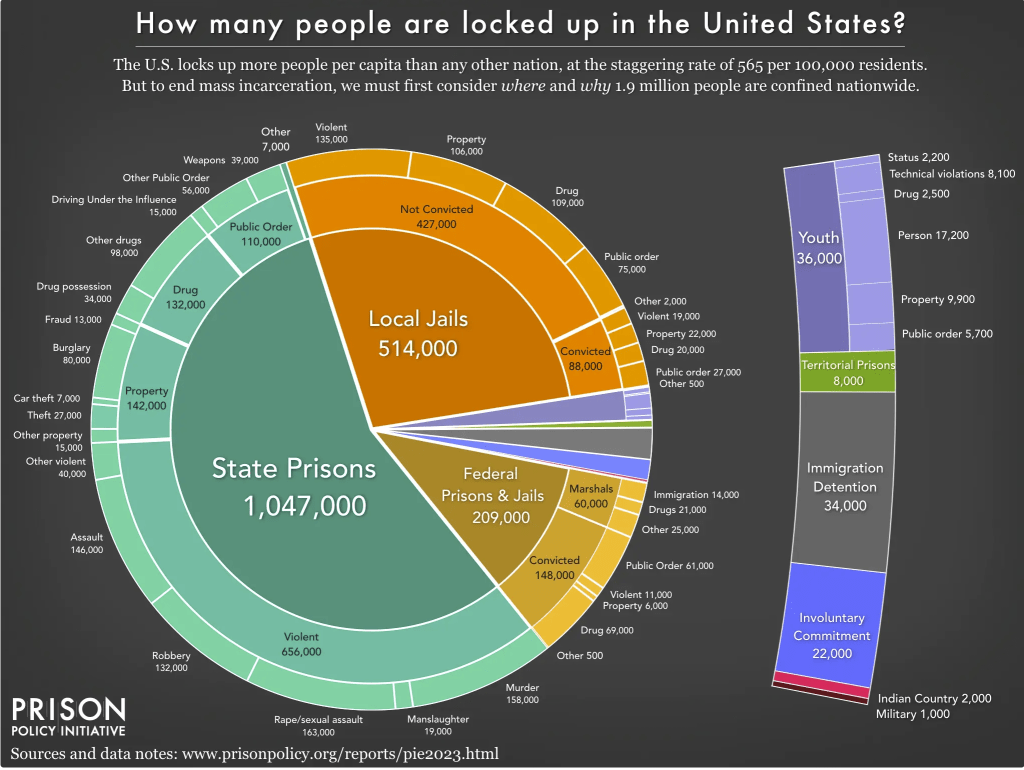By Kyle Harris
My potential career interests include the criminal justice or law enforcement field, so I wanted my capstone to related to those particular fields. The topic of my capstone focuses on why the recidivism rates are so high in the United States, as well as what changes can be made in order to lower the recidivism rate. Recidivism is the tendency of a convicted individual to reengage in criminal behavior upon reentering society, resulting in their return to the criminal justice system after serving a previous sentence. Specifically, I will look at how punitive and rehabilitative approaches in the United States prison system can be balanced in a way that will be most effective for society and the prisoners themselves in terms of reintegration back into society.
The punitive approach to punishment in prison systems is characterized by a focus on retribution and deterrence. Under this philosophy, the primary goal of incarceration is to punish offenders for their crimes. This approach often involves imposing strict sentences, harsh living conditions, and limited privileges to create an environment that is meant to be punitive and discouraging (Raymond, 1979). Politicians adopted a “tough on crime” approach starting in the 1970s that has resulted in around 2 million Americans that are currently incarcerated and another 3 to 4 million Americans on probation or parole (Sawyer & Wagner, 2023).

The rehabilitative approach to punishment, on the other hand, emphasizes the transformation and reformation of offenders through targeted interventions and programs. Unlike punitive models that focus solely on punishment and deterrence, the rehabilitative approach aims to address the root causes of criminal behavior and equip inmates with the skills and support needed to reintegrate into society successfully. This approach often involves educational programs, vocational training, counseling, and mental health services to help individuals develop the necessary tools to lead law-abiding lives upon release (Forsberg & Douglas 2020). Norway, one of the most prominent nations in the focus of rehabilitation in their prison systems, reported one of the lowest recidivism rates in the world with a rate of 20% (Denny, 2016).
There are many reasons why we should care about working to lower the recidivism rates in America. According to the U.S. Bureau of Justice Statistics report, the recidivism rate for inmates in state prisons was 68% in 2020 (Jackson, 2020). The high recidivism rates in America indicate that the current correctional system may not be adequately addressing the root causes of criminal behavior or providing effective ways of integrating incarcerated individuals back into society. If individuals leave prison without the necessary tools and support to reintegrate into society, they have a high chance of facing challenges that increase the likelihood of returning to criminal activities. High rates of recidivism also place a strain on both federal and state budgets. The average annual cost of incarceration fee for a Federal inmate in a Federal facility was $39,158 (Bureau of Prisons, 2021). The cost of incarcerating individuals is substantial, and when offenders reoffend, it perpetuates a cycle of incarceration, leading to increased financial burdens on the criminal justice system.
While South Dakota, with a recidivism rate of 40.3% over a three year span from 2019-2022 (SD Department of Corrections, 2022), does not have a high rate compared to the rest of the country, seeing these rates go down in our own community would have very positive effects. Ninety-five percent of individuals currently incarcerated in the state of South Dakota will eventually be released. This highlights why it is important that while they are incarcerated, these inmates are provided with the necessary tools needed to become contributing members of society as they are released. The benefits that would be seen from the successful reintegration into society from these inmates would be felt in both the economy and the community as a whole.
My exploration of punitive and rehabilitative approaches in the criminal justice system involves a reflection on the real-world consequences of these methods. I am hoping that my project serves as a call to action, highlighting the ripple effects of high recidivism rates on societal safety, economic resources, and community well-being. There is a need in America for a nuanced and balanced approach to punishment. One that not only holds individuals accountable but also equips them with the tools for successful reintegration into society.
References
Annual Determination of Average Cost of Incarceration Fee (COIF). (2021, September 1). Federal Register. https://www.federalregister.gov/documents/2021/09/01/2021-18800/annual-determination-of-average-cost-of-incarceration-fee-coif.
Denny, Meagan (2016) “Norway’s prison system: Investigating recidivism and reintegration,” Bridges: A Journal of Student Research, 10 (10).
External data brief: Adult recidivism. (2023, March). South Dakota Department of Corrections. https://doc.sd.gov/documents/Data%20Brief%202.E%20Adult%20Recidivism.pdf.
Forsberg, L., & Douglas, T. (2022). What is criminal rehabilitation?. Criminal law and philosophy, 16(1), 103–126. https://doi.org/10.1007/s11572-020-09547-4.
Jackson, L. (2020). Prison is not for punishment. Aba Journal, 106(1), 9–10.
Raymond, F. B. (1979). Reasons we punish. Journal of Humanics, 7(2), 65–78.
Sawyer, W., & Wagner, P. (2023). Mass incarceration: The whole pie 2023. Prison Policy Initiative. https://www.prisonpolicy.org/reports/pie2023.html
Kyle Harris is a Science, Technology, & Society major. I am on the basketball team, and some of my hobbies include hanging out with friends and watching movies. The reason I chose STS as my major is due to the flexibility it has in career paths. Upon graduation, I plan on either going to graduate school for counselling or entering the criminal justice and/or law enforcement field.
